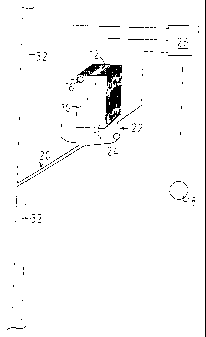Some of the information on this Web page has been provided by external sources. The Government of Canada is not responsible for the accuracy, reliability or currency of the information supplied by external sources. Users wishing to rely upon this information should consult directly with the source of the information. Content provided by external sources is not subject to official languages, privacy and accessibility requirements.
Any discrepancies in the text and image of the Claims and Abstract are due to differing posting times. Text of the Claims and Abstract are posted:
| (12) Patent: | (11) CA 2455744 |
|---|---|
| (54) English Title: | WIND ENERGY INSTALLATION |
| (54) French Title: | INSTALLATION D'ENERGIE EOLIENNE |
| Status: | Term Expired - Post Grant Beyond Limit |
| (51) International Patent Classification (IPC): |
|
|---|---|
| (72) Inventors : |
|
| (73) Owners : |
|
| (71) Applicants : |
|
| (74) Agent: | OYEN WIGGS GREEN & MUTALA LLP |
| (74) Associate agent: | |
| (45) Issued: | 2009-02-03 |
| (86) PCT Filing Date: | 2002-07-01 |
| (87) Open to Public Inspection: | 2003-02-20 |
| Examination requested: | 2004-01-28 |
| Availability of licence: | N/A |
| Dedicated to the Public: | N/A |
| (25) Language of filing: | English |
| Patent Cooperation Treaty (PCT): | Yes |
|---|---|
| (86) PCT Filing Number: | PCT/EP2002/007225 |
| (87) International Publication Number: | WO 2003014629 |
| (85) National Entry: | 2004-01-28 |
| (30) Application Priority Data: | ||||||
|---|---|---|---|---|---|---|
|
The present invention concerns a wind power installation, in
particular a wind power installation having an apparatus for the
dehumidification of a gaseous medium in a substantially closed space within
the wind power installation. In order to keep down the personnel and
logistical expenditure for attaining proper operability of the apparatus, to
simplify the structure and to permit very substantially maintenance-free
operation, the apparatus includes a first aereal element and a cooling
device for cooling the first element to a temperature below the ambient
temperature.
La présente invention concerne une installation d'énergie éolienne, notamment une installation d'énergie éolienne comprenant un dispositif conçu pour déshydrater un milieu gazeux dans un espace sensiblement clos, à l'intérieur de cette installation d'énergie éolienne. L'objectif de la présente invention est de minimiser les ressources en personnel et en logistique nécessaires pour maintenir le bon fonctionnement du dispositif, de simplifier la construction et de minimiser l'entretien. A cette fin, le dispositif comprend un premier élément plan (10) et un dispositif de refroidissement (12) conçu pour refroidir ledit premier élément à une température située en-dessous de la température ambiante.
Note: Claims are shown in the official language in which they were submitted.
Note: Descriptions are shown in the official language in which they were submitted.

2024-08-01:As part of the Next Generation Patents (NGP) transition, the Canadian Patents Database (CPD) now contains a more detailed Event History, which replicates the Event Log of our new back-office solution.
Please note that "Inactive:" events refers to events no longer in use in our new back-office solution.
For a clearer understanding of the status of the application/patent presented on this page, the site Disclaimer , as well as the definitions for Patent , Event History , Maintenance Fee and Payment History should be consulted.
| Description | Date |
|---|---|
| Inactive: Expired (new Act pat) | 2022-07-04 |
| Letter Sent | 2022-01-04 |
| Letter Sent | 2021-07-02 |
| Inactive: COVID 19 - Deadline extended | 2020-06-10 |
| Common Representative Appointed | 2019-10-30 |
| Common Representative Appointed | 2019-10-30 |
| Inactive: IPC expired | 2016-01-01 |
| Inactive: IPC expired | 2016-01-01 |
| Grant by Issuance | 2009-02-03 |
| Inactive: Cover page published | 2009-02-02 |
| Pre-grant | 2008-11-18 |
| Inactive: Final fee received | 2008-11-18 |
| Notice of Allowance is Issued | 2008-10-22 |
| Letter Sent | 2008-10-22 |
| Notice of Allowance is Issued | 2008-10-22 |
| Inactive: Received pages at allowance | 2008-08-27 |
| Inactive: Office letter | 2008-08-04 |
| Inactive: Approved for allowance (AFA) | 2008-07-18 |
| Amendment Received - Voluntary Amendment | 2008-05-22 |
| Inactive: S.30(2) Rules - Examiner requisition | 2007-11-23 |
| Amendment Received - Voluntary Amendment | 2007-03-16 |
| Inactive: S.30(2) Rules - Examiner requisition | 2006-09-18 |
| Inactive: IPC from MCD | 2006-03-12 |
| Inactive: IPRP received | 2004-05-14 |
| Inactive: Cover page published | 2004-03-23 |
| Inactive: Acknowledgment of national entry - RFE | 2004-03-19 |
| Inactive: Inventor deleted | 2004-03-18 |
| Letter Sent | 2004-03-18 |
| Application Received - PCT | 2004-03-02 |
| National Entry Requirements Determined Compliant | 2004-01-28 |
| Request for Examination Requirements Determined Compliant | 2004-01-28 |
| All Requirements for Examination Determined Compliant | 2004-01-28 |
| Application Published (Open to Public Inspection) | 2003-02-20 |
There is no abandonment history.
The last payment was received on 2008-05-23
Note : If the full payment has not been received on or before the date indicated, a further fee may be required which may be one of the following
Please refer to the CIPO Patent Fees web page to see all current fee amounts.
Note: Records showing the ownership history in alphabetical order.
| Current Owners on Record |
|---|
| ALOYS WOBBEN |
| Past Owners on Record |
|---|
| None |